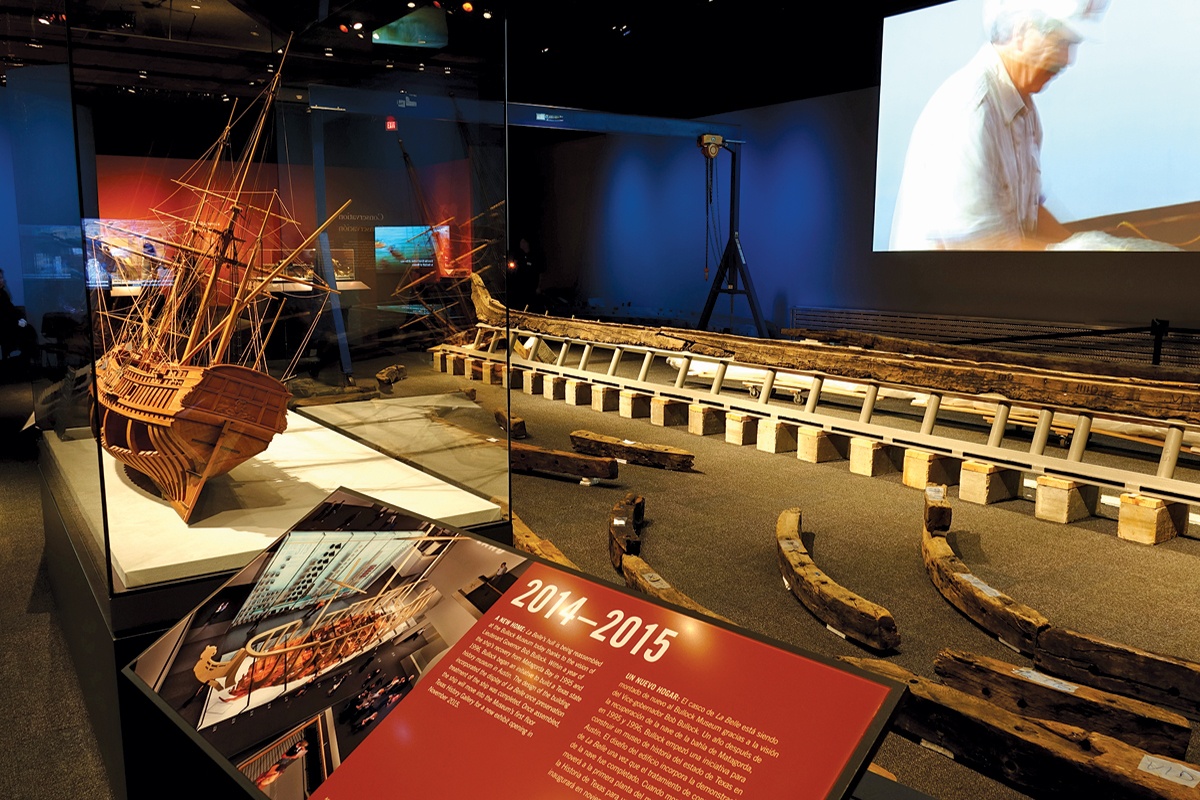The story of the failed French settlement of Texas holds center stage at the Bob Bullock Texas State History Museum with the reconstruction of La Belle, the centuries-old lost ship of Robert Cavalier, Sieur de La Salle.
“The sinking of La Belle doomed La Salle’s effort to colonize the Texas coast,” says Jim Bruseth, guest curator of the exhibit, “and it opened the door for Spain’s occupation of Texas.”
In the 1990s, Bruseth led a team of Texas Historical Commission archaeologists responsible for recovering the ship from Matagorda Bay. The archeologists’ efforts launched an unprecedented excavation and restoration effort that tells the story of an early attempt to colonize North America.
La Salle’s dream of establishing a French colony sank in Matagorda Bay in February 1686 when his last surviving ship, La Belle, ran aground a quarter mile from shore in 12 feet of water. The cantankerous La Salle was away searching for the mouth of the Mississippi when his beautiful barque longue listed to starboard and settled onto the seabed. Soon after this disaster, La Salle’s crew assassinated him.
The Bullock exhibit is more than 30 years in the making. In 1978, Barto Arnold, Texas state marine archaeologist, discovered the probable site of the wreck in a magnetometer survey. Lost for more than 300 years, the 60-foot vessel presented challenges for archaeologists as soon as recovery work began in 1995. The ship lay in a remote part of the bay where the muddy water made underwater excavation impossible. The THC elected to construct a cofferdam, a huge double steel wall driven into the seabed, to surround the wreck. With the cofferdam in place, water could be pumped out to allow a relatively dry excavation.
Most of La Belle’s cargo was intact, housed in wooden boxes and barrels, some of which could be removed in their entirety. The challenge for archaeologists was to keep the waterlogged artifacts and the hull itself from drying out and decomposing. “Wood that has been submerged in seawater for 300 years shrinks, cracks and warps within a matter of days if allowed to dry out,” explains Amy Borgens, THC nautical archaeologist. “The enormous physical stress on the timbers causes them to crumble and break into pieces if exposed to the air.”
Before proceeding with restoration, the Abandoned Shipwreck Act required Texas to sign a treaty with France for conservatorship of the vessel for 99 years. Because La Belle was a French flagship, France will retain ownership, and the THC will serve as principal steward.
Carefully wrapped timbers from the ship’s hull traveled by truck to Texas A&M University’s Conservation Research Laboratory, where scientists working in partnership with the THC processed the artifacts and timbers. “The greatest enemy of shipwrecks is ship worms, which riddle submerged wood with tunnels in temperate waters,” says Peter Fix, lead conservator on the La Belle project at Texas A&M. “The bulk of La Belle’s hull was already decimated by ship worms when it was located by the Spanish in 1689. Only the parts buried beneath the mud, about the bottom third of the hull, have survived.”
Scientists at A&M soaked La Belle’s timbers in fresh water in a cradle built to support the wood in its original shape. After leaching out the salt, they submerged the wood in a solution of polyethylene glycol, also known as PEG, in a preservation process that normally would have required 10 years. During this process, PEG is gradually impregnated into the wood to replace water. Unfortunately, the price of polyethylene glycol skyrocketed from $330,000 for the project to more than $1.5 million, and the THC was forced to consider other options.
The laboratory submitted a proposal to the THC that listed other available methods for preserving waterlogged wood. At the top of the list was freeze-drying, an alternative that had not been tried on such a large scale. Freeze-drying, also known as sublimation, requires only 10 percent of the amount of PEG needed for the originally proposed method.
Although freeze-drying a ship would prove much more difficult than freeze-drying a tomato, scientists felt confident the system would work. Inside the freeze-dryer, which is set to minus 40 degrees and 0.06 atmospheres of pressure, ice transforms directly from a solid into a gas, thus reducing the time needed to treat the hull and simultaneously imbuing the wood with a more natural appearance. “Planking took approximately six weeks to dry sufficiently, but larger wood like the keel and frames took longer—three to four months,” says Donny Hamilton, nautical archaeology program director at A&M.
Built specifically for this project, the freeze-dryer is the largest archaeological freeze-dryer in the hemisphere. The tube-shaped, computer-controlled instrument measures 8 feet in internal diameter by 40 feet in length. Five racks inside the freeze-dryer compartment hold artifacts in position. The freeze-dryer will have a waiting list of projects after La Belle, including restoration of objects from a museum that suffered water damage during Hurricane Katrina in 2005.
La Belle began to take shape on the ground floor of the Bullock Museum on October 25, 2014. Visitors are invited to watch the reconstruction process. The ancient timbers need the support of an endoskeleton made of carbon fiber laminate. “Many of the artifacts will eventually be displayed in the hold in their original positions,” says one official, “including a mold of the skeleton of an unfortunate sailor who went down with the ship.” The museum, still in its planning phase when La Belle was discovered in 1995, has a gallery especially designed to display the ship.
Completion is scheduled for May 17, at which time the finished ship will move to its permanent location inside the museum. The artifacts, which number
1.6 million, will change over time. Most have never been on display before. The museum will recreate the ship’s original three masts and support beams so that visitors can see an interpretation of the parts that rotted away over the centuries while the ship lay on the floor of Matagorda Bay.
“La Belle is the only wreck where the supplies needed to start a New World Colony have been found together and so well preserved,” says Bruseth. “They represent a ‘kit’ for building a colony.”
——————–
Martha Deeringer, a member of Heart of Texas EC, lives near McGregor.



